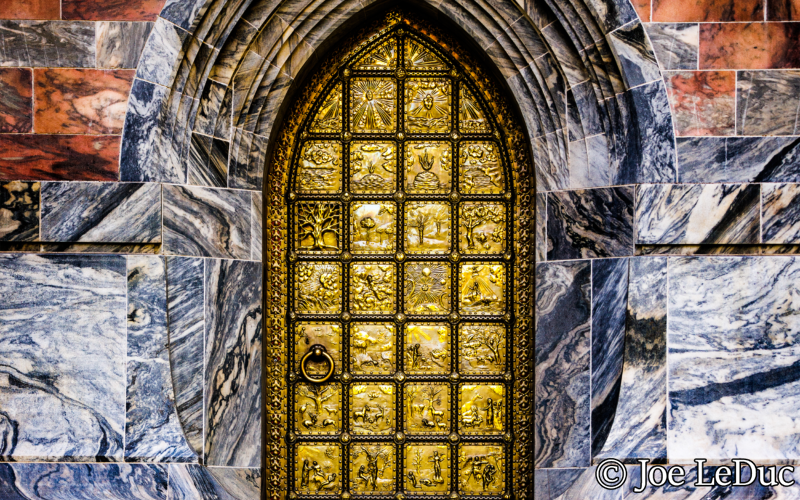Intricate, Carefully Planned Details Make Carillon Tower One of a Kind
by TIM CRAIG
Even the drive into Bok Tower Gardens is a work of art.
As the road twists and winds, the trees and landscape alternately reveal and hide the 205-foot tower in a playful, hide-and-seek fashion. The drive into the gardens creates an air of mystery, says Tricia Martin, director of visitor engagement, and its design was very intentional.
“The way the man-made structure and the sea of agriculture that surround it coexist was very much one of the things that Edward Bok wanted to showcase,” she says. “Together, they create an incredible work of art.”
While the gardens in their entirety showcase art in nature and agriculture — from Pinewood Estates to its diversity of native and exotic flora and fauna — it is the Singing Tower, a registered national landmark, that is the central masterpiece. Yet even this central masterpiece is a mini-gallery of art in its own right, and for guests who take the time to look and ponder, it offers its own delights.
The tower, which opened in 1929 with a ceremony featuring President Calvin Coolidge, is modeled in part after St. Rombold Cathedral of Mechelen in Belgium in a Neo-Gothic style. Architect Milton Medary used pink and gray granite from Georgia and coquina from St. Augustine to construct the tower, which sits at 51-feet square at its base and changes into an octagon just over halfway up.
The Singing Tower houses a world-class carillon, with 60 bells ranging from 16 pounds to nearly 12 tons.
“The tower itself is an amazing and beautiful object, but it is also a very solid structure,” Martin explains. “It was built to house an incredible musical instrument, and it has withstood the test of time.”
Along with Medary, Bok worked with other top artisans of the day to imbue the tower with the artistic flourishes that reflect his philosophy on man’s place in the world.
One popular feature is The Great Brass Door and wrought iron gates on the north side of the tower. Designed by America’s premier metalworker at the time, Samuel Yellin, the bronze door is divided into panels that depict the Book of Genesis, from the creation of light to the ousting of Adam and Eve from the Garden of Eden.
Yellin hand-wrought the iron gates, which feature zoomorphic figures with various expressions and wings for flight.
The bronze door, with its fine details, is one of the challenges that face Bok Tower workers.
“We are still refining how we take care of the door,” explains Martin. “Some methods we were using, we found that we were polishing too much, which was affecting the details of the artwork. Now we don’t polish it as much.”
Sculptor Lee O. Lawrie, a first-generation immigrant from Germany, designed the marble sculptures that adorn the tower. Continuing the theme of the balance of humanity and nature, Lawrie’s sculptures are mostly made up of American birds and plants — including eagles, doves carrying oak branches as symbols of peace, seahorses, pelicans, hares, foxes and baboons. In addition to the plants and animals, there are depictions of the Bible, Aesop’s Fables and a boy who is seen sowing seeds on one side, and feeding animals on another.
“The art of the tower truly reflects a celebration of nature and man’s place within it,” says Martin.
That theme is prevalent in the work of tilemaker J.H. Dulles Allen, who created the intricate tile grilles that decorate the opening of the bell chamber. The grilles help filter the sounds of the carillon as its music cascades through the garden. He also designed the tile floor of the Founder’s Room just inside the tower. Working with metal and tile, Allen transformed plants and animals into a distinctive piece of art. His colorful tiles are found only in the top third of the tower.
“What’s really remarkable about the tower is the coming together of all these artists, each of whom was well-known in the field and were each given incredible license to express their own vision,” Martin explains. “And yet, it comes together so seamlessly and all fits within the larger vision of what Bok Tower represents.”
Making sure that vision of man in nature stays intact represents a daunting challenge for Bok Tower Gardens, says Martin.
“I have always appreciated the bigger picture of what this place represents, of a majestic tower in the context of an agricultural landscape, which was the intention of Bok when he built it,” she says. “But as the groves shrink and we see more rooftops, we are faced with something very different from what Bok and the others who built this place intended. We need to be very proactive in preserving and protecting this experience.”

